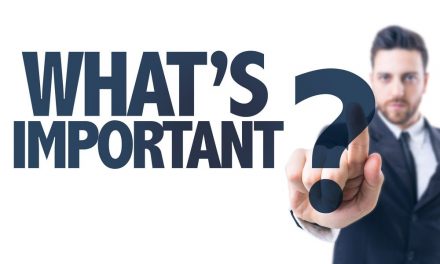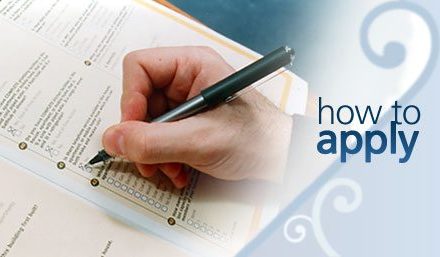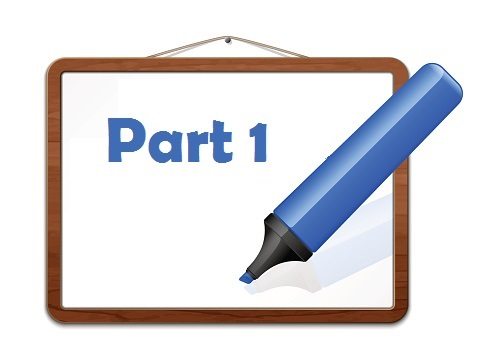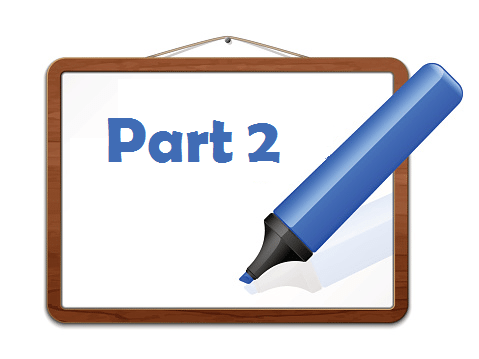1.Understand the Beast
First of all, don’t panic. Knowing exactly what you need to do in order to pass helps confine your goal into something concrete and workable.
The passing score is 360 out of 500. This means that you do NOT need to maximize your score. Many readers fall into this trap of spending as much time as they need to “perfect” one study unit before moving on, thus seriously running out of time for the rest of review materials.
A smart candidate should “optimize” instead of maximize your study effort. Remember the 80/20 rule: set a comfortably high standard of 80-85% accuracy for your practice test questions.
Similarly, while you should cover all study materials, it’s okay to be confident in most but not all (say 80-85%) of exam content. You can always go back and go for a higher target when time permits.
2. Pick the Right Tools
It is most important to pick a review material that fits your own background and learning style (not whether others say it’s good). I encourage you to:
- Read the pros and cons of major providers
- Sign up for free trials from the ones you like
- Play around with it for a few days
- Settle with one and begin studying
Unless you are very tight in budget, always get the latest version so you don’t need to worry about missing a few points due to outdated materials.
3. Persist with a Workable Plan
Creating a study plan takes time, effort, and is against human nature — most candidates understand the importance of getting organized but few actually implement it. That’s why so many candidates fail this exam.
A good plan makes sure you don’t fall behind and are able to cover all study materials given the time you have. Gleim and CMAexcel have excellent interactive online tools to map out a plan for you.
For those who study offline, you can download my study planner spreadsheet here.
4. Space Out Your Prep Time
Research has indicated that spacing out your studying time (e.g. reviewing 10 hours per week in the course of 2 months) is better than intense studying over a short period of time (e.g. 5 hours a day for 3 straight weeks).
Everyone has different learning patterns, but studying in the morning is in general better than late night cramming.
5. Immerse in “Real” Testing Environment
Try to practice in an environment similar to the actual exam. For example:
- Practice with questions online (because the exam itself is fully computerized)
- Study in a quiet, isolated work station. This could be your office, a undisturbed room at home, or the library
Being “effective” is different from being “efficient”. An effective student can learn more and perform better given the same amount of studying time.
6. Clean Your Desk
Studying in an uncluttered space with minimal distraction forces you to concentrate on your studies.
7. Restrict from Emails and Social Media
It’s not practical to stop checking your emails, Facebook and Twitter altogether; but you can certainly set a time of the day for that (e.g. 15 minutes each in the morning and evening), and be strict about it. You will be amazed how much concentration you can regain with this strategy.
8. Prioritize Based on Long Term Goals of Your Life
If you insist in watching that TV show or uploading your cat photos to Facebook, think about what these mean to you 10 years down the road. Would they get the promotion, the dream job and a better life for you and your family? Let’s prioritize based on our long term goals instead of short term enjoyment.
9. Minimize Sleep-In
Getting adequate amount of sleep is very important so I don’t suggest cutting back your resting time for CMA exam prep. However, you can make better use of the time when you are awake but not physically out of bed.
I’ve tried putting the alarm clock in the opposite side of my room, and have my favorite snack ready for me to grab as an extra incentive. Once the routine is established, it is much easier to keep the discipline.
10. Make Best Use of Idle Time
Some of you may have lots of time between activities, such as waiting to pick up kids for stay at home moms, and long commute for those living in suburbs.
With the proliferation of mobile devices, we are now able to study on the go in the form of audio review, streaming video instructions or test prep apps on smart phones. These learning tools may not work for everyone, but do explore and see if one fits your learning style.
If everything fails, the good old 3″x5″ handwritten flash cards always work for me. Give it a try.
11. Delegate. Outsource. Seek Help
Don’t be shy to ask for help from your husband/wife, parents, aunts, neighborhood friends and possibly colleagues. It makes them happy to feel helpful and appreciated during your CMA exam preparation.
If you have older children, it’s perfect time to give them extra responsibility for their own personal development.
12. Combine Family and Studying Time
I tried bringing my daughter to the library every Saturday morning, so she could read books beside me while I studied. I also flipped my flash cards when watching my little son shower. Be creative to find extra time for your studies.
Multiple choice questions represent 75% of the CMA exam. Therefore, the characteristics of MC questions determine the style of the test. For example, MC questions are generally used to test a wide variety of topics but they usually don’t go deep, as in they cannot ask you to analyze a scenario. Because of this, you can expect the CMA exam to be a mile wide or an inch deep.
13. Engage Your Brain When Studying
Your brain needs to be engaged when studying. Reading the text book over and over is too passive, and this affects retention.
How do you engage your brain? Give it something to do! Examples:
- Highlight the important parts of the book (not just reading paragraphs highlighted by someone else)
- Jog down notes on the margin
- Summarize the concept after watching the video, listening to an audio lecture, or reading the textbook
- Make flash cards as you go through the materials (instead of buying a set).
I personally find the process of reading / watching / listening and then writing out the key points help a lot in retention vs reading the materials alone.
Any of these methods will prolong your CMA exam prep but it’s totally worth the effort in my opinion.
14. Pay Attention to Key Definitions and Terms
This is true for multiple choice questions in any exams.
Examiners love to test fundamental concepts, definitions and terms in multiple choice questions. Therefore, make sure you understand the important terms and be able to differentiate them.
15. Know the Concepts (Not the Mnemonics) by Heart
There are CMA review courses that focus a lot on mnemonics. While these are useful don’t blindly memorize them without understanding the concept behind it. Also, don’t rush to complete all practice questions without a good grasp of the concepts.
16. Apply the Concepts at Work
As one of our bloggers Gavin suggested, we can practice important CMA exam concepts in real business situations, in our everyday work. It could be cost accounting, variance analysis, or internal control. Just keep an open mind and find opportunities to practice your skill.
Another characteristics of multiple choice questions that there is always a correct answer hidden among the 4 choices. The difficulty of the question depends on (1) whether you know the correct answer; and (2) whether you get tricked by any of the wrong answers.
17. Don’t Try to Outsmart the Examiners and Pick “Hot” Topics
Candidates are busy and they often make an educated guess or ask around on which topics they should focus on, given the limited amount of time for studying.
This approach is risky because you never know what’s on in each exam. Some topics e.g. cost accounting will certainly be on, but it doesn’t mean we can skip other seemingly off-the-track sections.
Time management and a good study plan (tips #3) is again very important when it comes to CMA exam preparation.
18. Understand How Multiple Choice Questions Work
Multiple choice questions require a special way of preparation when compared to the essay question. In each multiple choice question, the student is asked to identify the correct answer out of 4 possibilities.
Why MC questions are easy for some candidates:
- It is comforting to know that one of the choices must be correct.
- There are 100 questions: we don’t feel too bad if we miss a few of them.
- We are purely tested on our knowledge on the topic, instead of creativity, or analytical and writing skills.
… and at the same time could be difficult for other candidates:
- The answer keys could be confusing, as you may be required to pick the best answer out of a few possibly correct answers.
- Easily get distracted by factually correct but irrelevant answers.
- There are so many questions that your mind blanks out towards the end of the exam section.
Our goal is to identify our own weaknesses, and directly address those during the exam preparation.
19. Keep Track of Incorrect Answers with a “System”
It is critical to have a systematic approach in identifying and keeping track of incorrect answers.
Whenever you answer a question incorrectly (or answer it correctly but for the wrong reason), write down the reason for your answer choice on a note book. Did you not know the concepts? Write down the concepts you did not know. Did you not read the fact pattern carefully? Did you misread the call of the question? Or misread the answer choices? Make a note of that in your own cheat sheet.
20. Analyze Your Weaker Areas
Constantly review this cheat sheet. Does it reveal any patterns, such as:
- Wrong answers in certain topic?
- Wrong answers in certain type and format?
- Wrong answers in certain fact pattern?
The integrated review course has online tracking system to identify your weaker areas by various means.
21. Speed It Up
The CMA exam is known for its lengthy questions and complexity. Once you are familiar with the fact pattern and style of the questions, try moving faster and maintain the accuracy.
22. Refine Your Skill in Educated Guessing
It is not surprisingly that candidates repeatedly get caught by questions they have never seen before.
With this in mind, it is very important that candidates practice the art of “educated guessing” through during their study.
In other words, get practices on a large variety of topics and don’t skip around the questions if you don’t mind. Also, don’t be afraid of the “test mode” (vs study mode) — I don’t like the extra stress but that’s precisely why we have to overcome it!
Try your best to get the best answer by whatever means — it could be by elimination, by relating a concept you learned from your other exam for example… this skill is going to be critical in the actual exam.
23. Don’t Run Away from the Mock Exam
The most important lesson to learn from mock exam is time management.
If you are running out of time, skip and mark anything you don’t know or don’t feel comfortable with. If time becomes an issue, the one complicated question was the one you don’t answer rather than 2 easy ones.
Multiple Choice Test Taking Tips
The best way to get prepared is to study all topics of the exam. Other than that, these tips can help you avoid silly mistakes and make better educated guess on the exam day.
A. Cover All Questions and Answers
This exam is positively graded: Even blind guessing would give you 25% chance of success. Therefore, you should always aim to complete the entire section.
24. Manage Your Time
This is rule number 1. The multiple choice in the CMA exam tends to be more lengthy and complex than other professional accounting exams. This makes time management critical. Generally speaking, you can allocate 3 hours (180 minutes) evenly to the 100 questions, which means 1.8 minutes per question.
25. Read All Choices before Picking the Answer
Many candidates pick the answer that “looks correct” and rush to the next question. But sometimes, there could be a better answer in B, C or D, or that you can choose “all of the above” when all answers are correct.
Always read the 4 possibilities before selecting the answer.
26. Don’t Leave Any Questions Unanswered
There is no penalty for wrong answers. If you run out of time, blind guessing is better than leaving them blank.
In theory, the correct answer is hidden among the 4 answer choices. If you study well, you should be able to identify it. In reality, however, many diligent candidates fail despite spending hundreds of hours in studying.
In most cases, they fall victim to the “distractors”. Here are tips on how to overcome them:
27. Anticipate the Correct Answer before Reading the Choices
Sometimes, the available answer choices look “reasonable” and they could do more harm then good by throwing you off and distracting you. In fact, the 3 incorrect answer choices are technically known as “distractors”.
You should always come up with the answer in your head before looking at the choices. If your answer matches with one of the responses, then you can be certain that the particular response is correct.
28. Select Answer that are Correct and On Topic
Some responses may be correct but are not directly related to the question. The best answer should be both correct and relevant.
29. Eliminate “Partly True” Answers
Similarly, ask yourself whether the answer you are considering completely addresses the question. If the answer is only partly true or is true only under certain narrow conditions, then it’s probably not the right answer.
30. Be Careful with Absolute Statements
When you see words such as “always”, “every”, “never” and “none” in the response, they are likely to be incorrect. The CMA exam cover topics in real business situations, and there are very few absolutely right or wrong situations in real life.
31. Be Careful with Negatives
Watch for negatives, double negatives and two part statements in the stem (thankfully, double negatives seem to be quite rare in this exam).
In general, I don’t think the CMA exam is trying to trick us, because they do bold the “not” in this case. Having said that, these words are key because they reverse the meaning of a sentence, and therefore, should be careful.
32. Avoid Weird or Funny Responses
Again, use your common sense. If the answer choice is funny or doesn’t make sense in real life situation, it is probably wrong.
In cases where you aren’t sure which answer is right, you can still greatly improve your odds by eliminating implausible answers. For example, removing two of these improves your odds of guessing the correct answer from 25% to 50%.
33. Look for Grammatical Clues
If the “stem” (body of the question) ends with “an” instead of “a”, then the correct response most likely begins with a vowel.
34. Pick the Answer with the Most Information
If a response repeats the keywords used in the stem, or that it is longer with more descriptive words (as if the examiner is trying to be specific about the description), it is more likely to be the correct answer.
35. Use the True/False Technique
This is helpful when you are confronted with 2 similar answers: If any part of a potential answer is false then the entire answer is incorrect.
The CMA exam often tests on real business situations. If everything fails or time is running out, pick the answer
36. Don’t Over-Analyze
Don’t dismiss a response because it seems too obvious and simple. If you are well prepared for the exam, some questions may appear very straight forward.
Similarly, don’t waste time looking for tricks and traps. Usually they are not there.
37. Follow Your First Impression
Multiple choice is all about recognition of things you have learned. If you are well prepared and you have read the question and choice of answers carefully, your first impression is often the best.
38. Eliminate the Choice that Doesn’t “Feel” Right
If you get stuck, try imagining each choice as the correct answer. People often “feel” that one of the answers is wrong. This happens when you are familiar with a concept but don’t have a firm grasp at it, just like you may know a person but you can’t recall his name.
The CMA exam is fully computerized. The system pulls a set of questions from a pool and present them in random order. Therefore, don’t waste time looking for patterns in your answers. Don’t worry if you find you have checked four “C” answers in a row.
40. Understand the Essay Grading System
Essays are graded using a standard scoring rubric to test your:
- Knowledge of the exam content
- Ability to apply concepts in real business situations
- Ability to express clearly and logically in business writing
Therefore, what you write (the content) and how you present the content are both important.
41. Get Familiar with Formatting
In the actual exam, the writing is done on a simple word processor that is similar to Notepad. For essays that require a computational answer, you should create simple tables and show calculations within the word processor space provided (spreadsheet function is no longer available in the CMA exam).
To avoid wasting time fixing the formatting on exam day, you should find a software that allows practice in a simulated testing environment. Gleim and Wiley have such features in their online platform.
42. Practice Answering MC Questions in “Essay Style”
Readers often ask for efficient ways to study for the essay portion. My suggestion is to pick a few multiple choice questions, and answer them as if they are essay questions.
It is best to type out the answers on a computer; but if you don’t have the time, try to go through this exercise at least once every day. Once your brain is trained to answer questions in this format, you will no longer worry about essays in this exam.
43. Steer Clear of Cyberslang
This hasn’t been an issue a few years ago, but I have seen more and more readers writing to me using seriously broken English full of text message jargon, abbreviations, initialisms and cyberslang. I can’t imagine how many points they lose if they write essays in this style!
Please start writing everything in proper grammar from now on, so that your brain is (re)accustomed to business writing.
44. Organize Thoughts and Writing with Intro, Main and Conclusion
Clarity is an important part of the grading system. When you address a question, always organize your thoughts in three parts: the introduction (reflecting what has been asked in the question), the main point (your opinion or ideas), and a conclusion.
45. Don’t Get Lost in Your Scratch Paper
You are given scratch paper for computational work and for organizing your thoughts of the essays. Try to write quickly but neatly. Label the paper with the question number will help a lot if you have the time to go back and check your work.
These tips are all about managing y0ur psychology the night before, and get mentally prepared on exam day.
46. Drop the Emotional Baggage
Tell yourself that it’s not the end of the world if you fail. Don’t overload your anxiety with the “what if” scenarios, such as how the failure could impact the promotion, the salary raise and job search.
Focus on things in your control, i.e. what you can do at the present, instead of things out of your control, i.e. possibilities in the future.
47. Narrow Down Your Goals on the Exam Day
What you are trying to achieve on the exam day is simply to:
- Complete the section on time
- Select the best answer based on what you’ve learned
- Use the exam taking techniques in case you need to guess the answer
Things become a lot more manageable with 3 simple and clear goals.
48. Sleep Tight the Night Before
This is cliche but very important. Your brain can’t function without sufficient rest. The last thing you want to do is to cram straight for 12 hours and fry your brain cells the night before.
49. Avoid Forums a Few Days before Exam
I understand that many self-study candidates go to exam forums to vent and to look for encouragement. This is all good, but I would stop doing that a few days before the exam.
This is to avoid interacting with fellow students with “negative energy” (could be those who haven’t well prepared, got too frustrated or are about to give up). You can’t afford to have these people distracting your mental preparation.
50. Say “I am Ready” 3 Times Before Entering the Exam Room
Confidence is a critical element to your success. It helps to bring down your anxiety which in turn improve your cognitive skills and your common sense.





